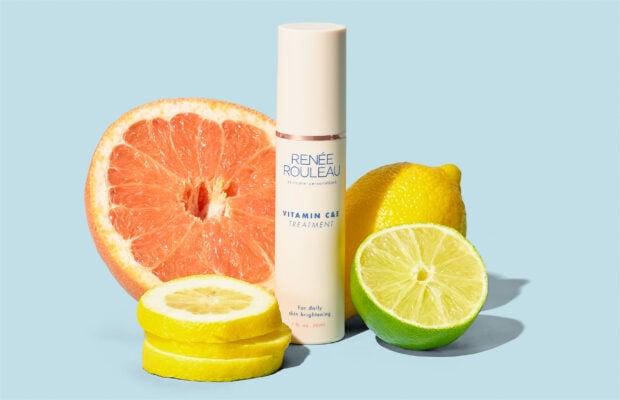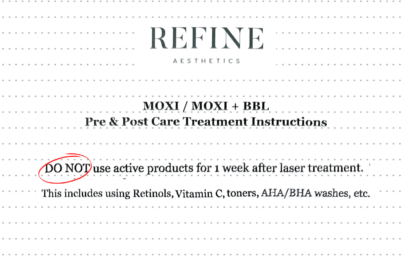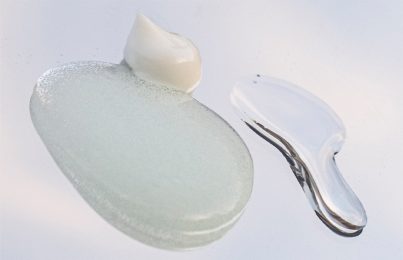Vitamin C, when used topically in a serum, is widely acclaimed as one of the best ingredients for brightening skin, boosting collagen production, and protecting skin against environmental damage. It’s so popular that even at the 2024 Medical Spa Show that I attended, vitamin C was a huge topic of conversation. However, not everyone is as positive about it as you may think. Whether you’re an esthetician, dermatologist, or just a skincare enthusiast, you’ve likely heard of one major downfall when it comes to this ingredient: the vitamin C acid burn.
So, what is this? Certain vitamin C formulas, when applied to the skin daily, can cause a burning and stinging sensation, along with redness, skin that’s hot to the touch or a general feeling of irritation. This occurs because a topical vitamin C is eliciting a nervous neural response in your skin. As your skin senses exposure, it tries to warn you against something it doesn’t want– in this case, a low pH product. However, I don’t believe this side effect should discourage you against vitamin C entirely– let me explain.
Benefits of Vitamin C In Your Skincare Routine
The addition of a topical vitamin C serum into your skincare routine can be extremely beneficial for your barrier and improve overall skin health. Here are the most notable reasons why.
- Brightens Skin Tone
- Likely the most revered benefit, vitamin C lessens pigment production in skin, making it look brighter.
- Boosts Collagen Production
- Not only does this ingredient help protect the collagen you already have by inhibiting enzymes that generally break it down, but it also aids in healthier collagen production.
- Protects Against Environmental Damage
- Vitamin C’s powerful antioxidant properties neutralize free radicals and protect the skin from damage caused by UV radiation, pollution, and other environmental stressors.
- Enhances Skin Hydration
- This ingredient has also been shown to have moisturizing properties, helping increase hydration levels and plump skin.
Understanding Vitamin C Sensitivity
Let’s get to the bottom of why this painful burning and stinging sensation sometimes occurs– and what you can do about it!
Why Does Vitamin C Burn or Sting?
The burning sensation is generally caused by three things:
- A really low pH. Low pH levels of 2.5-3.5 can potentially irritate the skin. They can increase the acidity of a serum, leading to a compromised barrier and a higher potential for stinging, especially for sensitive skin.
- A high quantity of ascorbic acid. This ingredient needs to have a minimum of 8% to have any efficacy in skin. At around 22%, the skin stops being able to absorb it. So most of these vitamin C serums that sting have a low pH and high quantity of ascorbic acid. This acid is a very small molecule, so it can easily get into the skin and disrupt its natural pH balance.
- A compromised barrier or recent use of actives. People who use active ingredients (retinol, retinoids, exfoliating acids, etc.) and people with compromised barriers are more likely to feel a stinging sensation. This is because when you use exfoliating acids or retinoids, you experience a lot of skin turnover, meaning that the skin on top is more raw and exposed. If you already have a reduced barrier and continue to use vitamin C, you won’t have enough lipids on your skin to help protect it from a product with a low pH. This is going to cause a more negative experience, and in turn, can actually lead to more inflammation.
Don’t Give Up – There’s a Solution!
Just because you may be dealing with a vitamin C acid burn, doesn’t mean you have to forego the ingredient entirely. There are still ways to receive all of the benefits of vitamin C– without the acid burn! Let’s discuss.
- What to avoid
- Low-pH Products: These can lead to long-term inflammation in the skin, causing accelerated signs of aging and increased pigmentation (once your body receives a signal that there’s inflammation, increased pigment production may occur). Look for formulas with a ph range of 5.0-5.8. A reputable brand should tell you the pH if it’s not publicly listed.
- A No-Pain-No-Gain Philosophy: Unlike retinol, pain (ie stinging) isn’t a sign of vitamin C efficacy but could be a sign of irritation.
- Vitamin C Sandwiching: While a retinol sandwich is a great way to receive all of the potent benefits of a retinoid without any of the dryness, flaking, or irritation, the same can’t be said for this ingredient. When sandwiching a vitamin C serum between two layers of moisturizer, it actually just impedes the ability of the ascorbic acid, rather than minimizing the potential side effects of vitamin C.
- What to do
- Look for Alternatives: There are plenty of vitamin C forms used in skin care, and which one you choose definitely matters. If you are experiencing a vitamin C acid burn, it’s time to look for a more stable formula. Keep reading to determine which one is right for you!
Finding Stability
Seeking out a stable vitamin C is the best way to avoid a vitamin C acid burn, but what exactly does this entail?
What Does A “Stable Vitamin C” Mean?
When you hear that a form of vitamin C is “stable,” this refers to the ability of the product to maintain its effectiveness over time and exposure to air, light, and temperature. A stable vitamin C will typically maintain its potency longer, be less prone to oxidization, and will likely contain supporting ingredients that increase efficacy.
Ever noticed your white or beige serum begin to turn yellow or light brown? This means the product has become unstable and begun to oxidize, meaning you are no longer receiving the entirety of its intended benefits.
It’s important to note that all skincare ingredients eventually expire, even the most stable of vitamin C serums. Make sure you use it before you lose it!
Why Do Vitamin C Formulations Matter?
Choosing the right vitamin C treatment may seem a bit complicated, but since vitamin C doesn’t always work the same, it’s important to understand their differences. Vitamin C formulations matter because they can greatly impact the stability, effectiveness, and overall performance of the vitamin C product. Factors such as active versus inactive forms of vitamin C, pH value, additional ingredients, or even texture, scent, and overall feel can greatly affect how your skin responds to a specific product.
What Makes Vitamin C&E Treatment Different?
What’s great about Vitamin C&E Treatment is that it doesn’t use high quantities of ascorbic acid and it has a more skin-friendly pH. Using both lipid and water-soluble forms of vitamin C, this serum provides potent antioxidant activity deep within the epidermal layers.
Utilizing tetrahexyldecyl ascorbate (THD), this skin-brightening cream ensures a slower release time than water-soluble molecules, meaning a longer window of active vitamin C and a lower potential for irritation. If you’re looking to benefit from all the benefits of vitamin C with none of the burn, this long-time best-seller is the one for you.
Tips for Choosing Stable Vitamin C Products
As intimidating as it may be, try not to be discouraged by the vast array of vitamin C products on the market. Here are a few tips for avoiding the pain and finding the perfect serum for you.
Ingredient Check
When it comes to common forms of vitamin C in skincare, there are four that come to mind: L-ascorbic Acid, Sodium Ascorbyl Phosphate, Ascorbyl Methylsilanol Pectinate, and Tetrahexyldecyl Ascorbate. Here’s how they differ.
- L-ascorbic acid: Despite being a tried and true ingredient, this is not your best bet when it comes to antioxidant protection. The only active form of vitamin C, L-ascorbic acid is incredibly unstable and, since it’s an antioxidant, it wants to react with almost everything in its environment. This means this ingredient has a high chance of oxidizing before it gets a chance to make it into your skin.
- Sodium Ascorbyl Phosphate: A great option for skin types that struggle from breakouts, this has been proven to help improve acne, but can still be quite reactive.
- Ascorbyl Methylsilanol Pectinate: A complex blend of many compounds rather than just a straightforward vitamin C derivative, this form has been shown to strengthen the membrane of skin cells and have improved delivery into skin.
- Tetrahexyldecyl Ascorbate: This is one of my personal favorites as it is the only oil-soluble form of vitamin C that I’ve mentioned so far. Because of this, it won’t react until it comes into contact with the oils in your skin, making it the most stable form of these four. Tetrahexyldecyl Ascorbate is also known to penetrate skin 20x more than ascorbic acid! Read all about why your skin will greatly benefit from THD Ascorbate.
Packaging Matters
As I mentioned, vitamin C serums can be highly unstable, reacting to almost everything from light and heat to oxygen, water, and metals. This is why product packaging can make all the difference.
This ingredient needs to be packed in opaque or tinted bottles that protect the product from light exposure, as light, especially UV light, can cause it to degrade and become less effective. Ideally, the product should also have an airless pump to minimize air exposure, keeping the serum fresh longer. Both of these will also reduce the risk of contamination, ensuring it can deliver its desired effects to the skin.
Vitamin C Application Techniques for Comfortable Use
Want to start your journey toward the best vitamin C for you but worried about the consequences? Here’s the best way to get started!
Patch Testing
While trying to find the right vitamin C product for you, it may take a bit of trial and error– but you don’t have to destroy your skin barrier in the meantime. Whenever anyone is trying out a new product, the first thing I do is recommend a patch test. Apply vitamin C to your neck (where skin is the most sensitive) to help determine what types of products or ingredients will cause a negative or allergic reaction on your face. This will help narrow down which skincare product or ingredient to test out in the future.
In conclusion, while vitamin C is a highly praised skincare ingredient known for its ability to brighten skin, boost collagen production, and protect against environmental damage, some people may experience the dreaded vitamin C acid burn. This burning or stinging sensation can be attributed to factors such as low pH levels, high concentrations of ascorbic acid, or a compromised skin barrier. However, I don’t think this should deter you from reaping the benefits of vitamin C. By understanding the causes of sensitivity and choosing stable formulations, you can incorporate vitamin C into your skincare routines effectively and comfortably. With the right approach, vitamin C can be a valuable addition to any skincare regimen, promoting healthier, more radiant-looking skin.
I hope you found this post informative! And as always, #obeyrenee
Celebrity Esthetician & Skincare Expert
As an esthetician trained in cosmetic chemistry, Renée Rouleau has spent 30 years researching skin, educating her audience, and building an award-winning line of products. Her hands-on experience as an esthetician and trusted skin care expert has created a real-world solution — products that are formulated for nine different types of skin so your face will get exactly what it needs to look and feel its best. Trusted by celebrities, editors, bloggers, and skincare obsessives around the globe, her vast real-world knowledge and constant research are why Marie Claire calls her “the most passionate skin practitioner we know.”



